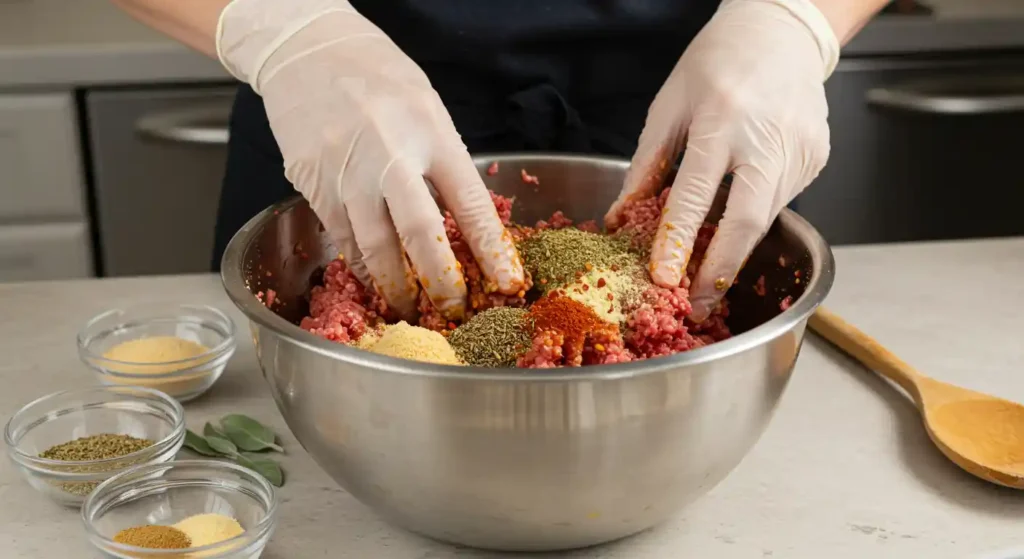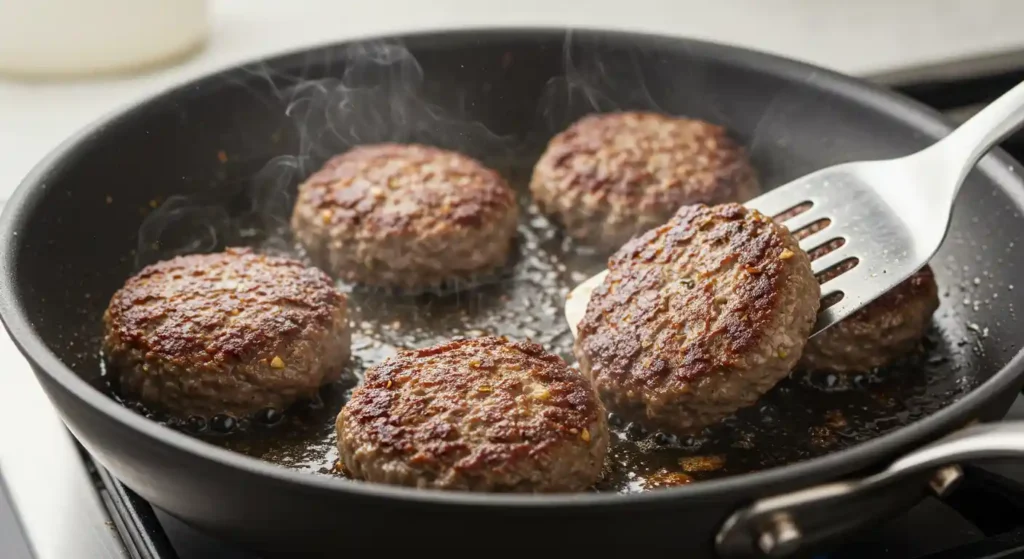Hearty, savory, and full of flavor—that’s what a good beef breakfast sausage should be. Whether you cook up a quick morning meal or plan an indulgent weekend brunch, homemade beef sausage brings robust taste with minimal fuss. By using ground beef and a classic blend of herbs and spices—like sage, thyme, and red pepper flakes—you capture the essence of morning sausage with a hearty, beefy twist. This homemade approach also lets you control salt levels, spiciness, and quality of the meat.

Cooking your own beef sausage ensures you know exactly what goes in. Whether you’re focusing on grass fed beef for better flavor or seeking to avoid additives often found in commercial sausage, this recipe puts you in charge. The process involves mixing a handful of pantry ingredients, forming patties or links, and pan-searing them in a skillet. In just minutes, you’ll have a pile of warm, juicy breakfast sausages ready to pair with eggs, pancakes, or toast.
Table of Contents
Why You’ll Love This Recipe
1. Customizable Flavor and Spice
Control the heat by adjusting red pepper flakes or black pepper. Swap out thyme for rosemary or add garlic powder if you crave extra depth.
2. Higher Meat Quality
Choose lean or grass fed ground beef. If you want more juiciness, look for ground beef with around 80–85% lean. Quality directly influences taste and texture.
3. No Fillers or Unwanted Additives
Commercial sausages can contain fillers, excess salt, and preservatives. Homemade sausage uses only the ingredients you select, making it more transparent and often healthier.
4. Quick to Make
Forming breakfast patties or links by hand is straightforward. Cooking them on a skillet over medium heat takes about 4–5 minutes per side, so you’ll have fresh sausage faster than a coffee run.
5. Versatile Cooking Options
Cook them in a large nonstick skillet or an oven if you prefer minimal stovetop splatter. Grilling will add a delicious smoky flavor.
6. Great for Meal Prep
Keep leftover cooked sausage in an airtight container in the fridge for up to 3–4 days. Reheat quickly for a stress-free morning. If you want to stock up, freeze extra patties for about 3–4 months.
7. Ideal for Varying Diets
Whether you’re cutting beef for dietary or personal reasons, or just want variety in your breakfast routine, beef sausage steps in perfectly. You can also reduce sodium or skip certain seasonings as you prefer.
Ingredients
To make a flavorful beef breakfast sausage, you’ll need the following:

- Ground Beef (1 pound)
- Preferably around 80–85% lean for moisture. Grass fed options bring out a deeper, richer flavor.
- Preferably around 80–85% lean for moisture. Grass fed options bring out a deeper, richer flavor.
- Salt (1 teaspoon)
- Essential for enhancing the savory taste of the meat.
- Essential for enhancing the savory taste of the meat.
- Black Pepper (½ teaspoon)
- Adds a subtle, peppery bite. Increase if you like extra spice.
- Adds a subtle, peppery bite. Increase if you like extra spice.
- Garlic Powder (½ teaspoon)
- Layers in a mellow garlic note. You can replace or supplement with onion powder.
- Layers in a mellow garlic note. You can replace or supplement with onion powder.
- Onion Powder (½ teaspoon, optional)
- Boosts overall aroma without actual onion bits in your sausage.
- Boosts overall aroma without actual onion bits in your sausage.
- Dried Sage (1 teaspoon)
- Key to that classic breakfast sausage taste. Dried thyme can be used in tandem or swapped in for variety.
- Key to that classic breakfast sausage taste. Dried thyme can be used in tandem or swapped in for variety.
- Dried Thyme (½ teaspoon)
- Complements sage and adds a subtle herb profile.
- Complements sage and adds a subtle herb profile.
- Red Pepper Flakes (¼ teaspoon, optional)
- For those who enjoy a slight heat, these flakes deliver a mild kick. Increase or omit depending on preference.
- For those who enjoy a slight heat, these flakes deliver a mild kick. Increase or omit depending on preference.
- Brown Sugar (1 teaspoon, optional)
- Helps balance out the savory flavors. If you like a hint of sweetness in your sausage, try it.
- Helps balance out the savory flavors. If you like a hint of sweetness in your sausage, try it.
- Vegetable Oil (1 tablespoon, if pan-frying)
- Helps prevent sticking in a nonstick or cast iron skillet. You can also use a nonstick spray if your pan is truly nonstick.
- Helps prevent sticking in a nonstick or cast iron skillet. You can also use a nonstick spray if your pan is truly nonstick.
Instructions
Follow these steps to craft a homemade beef breakfast sausage that’s juicy on the inside and lightly browned on the outside.
Step 1: Combine the Seasonings
- In a large mixing bowl, place ground beef.
- Add salt, black pepper, garlic powder, onion powder (if using), dried sage, dried thyme, and red pepper flakes. If you want a sweet-savory taste, stir in 1 teaspoon of brown sugar.
Step 2: Mix Thoroughly

- Use clean hands to gently mix the meat and spices. Avoid overworking the meat, as this can result in tougher texture.
- Ensure spices are evenly distributed throughout the beef.
Step 3: Shape the Patties

- Pinch off a small piece of the sausage mixture and cook it quickly in a small skillet or microwave to check flavor. Adjust seasoning if needed.
- Form the seasoned meat into patties—about 2–3 inches wide and ½-inch thick. This thickness helps them cook evenly without drying out.
Step 4: Cook the Patties

- Heat a large nonstick skillet over medium heat. If needed, add 1 tablespoon of vegetable oil to prevent sticking.
- Once the pan is hot, place the patties in a single layer. Do not overcrowd the skillet.
- Cook the patties for 4–5 minutes per side, or until browned and cooked through. The internal temperature should reach 160°F (71°C) for ground beef, ensuring safety and doneness.
Step 5: Drain and Serve
- Move the cooked patties onto a plate lined with paper towels to drain excess fat.
- Enjoy immediately, or keep them warm in an oven set to low heat while you finish a bigger batch.
Pro Tips and Variations
- Select the Right Beef
Leaner ground beef may make your patties drier. If you prefer a moist patty, 80–85% lean is a good target. Grass fed ground beef tends to have a heartier taste. - Adjust Herbs
If you love intense herb flavors, use more sage or thyme. For a spicier sausage, add more red pepper flakes or even cayenne pepper. - Form and Freeze
If you want a quick breakfast solution, shape the patties and freeze them on a tray. Transfer the frozen patties to a freezer-safe bag. Thaw overnight in the fridge before cooking or cook from frozen with extra time. - Explore Other Meats
You can also combine beef with ground turkey or ground chicken if you’re aiming for a lighter or more varied protein blend. - Cook in the Oven
If you prefer less stovetop cleanup, bake patties at 375°F (190°C) for about 15–20 minutes, flipping once. Check the internal temperature to ensure they reach 160°F.
Serving Suggestions
1. Classic Breakfast Plate
Pair these patties with scrambled eggs, hash browns, and toast. The rich beef flavor balances eggs and carbs nicely.
2. Breakfast Sandwich
Place a patty on an English muffin or biscuit. Add cheese, a fried egg, or some jam to create a sweet-savory combo.
3. Brunch Board
Serve the patties alongside fruit, yogurt, and pastries. This approach suits a communal brunch spread with varied tastes.
4. High-Protein Snack
Enjoy a patty on its own between meals. This approach is especially handy if you’re limiting carbs or looking for a protein boost.
5. Toppings and Condiments
Try hot sauce, ketchup, or even maple syrup if you like a sweet-savory twist. A dollop of honey mustard can also complement the herbs and spice.
Conclusion
Making beef breakfast sausage at home allows you to control taste, quality, and add a personal spin to your morning meal. The combination of ground beef, a few basic spices (like sage, thyme, and red pepper flakes), and a simple cooking method results in skillet patties that are flavorful, hearty, and free from the additives often found in store-bought sausage.
These patties cook fast—just a few minutes per side—and pair well with your favorite breakfast classics like eggs, pancakes, or hash browns. You also have the freedom to store extras in the fridge or freezer, so you can quickly reheat them on hectic mornings. Once you get comfortable with the base recipe, you can adjust the herbs, experiment with spice levels, or even blend different meats to expand your breakfast sausage repertoire.
So, if you’ve been searching for a homemade beef breakfast sausage recipe that offers more control and richer flavor than store-bought options, give this easy approach a try. Your taste buds (and family) will thank you for the effort.

Beef Breakfast Sausage
Ingredients
Ground Beef (1 pound)
- Preferably around 80–85% lean for moisture. Grass fed options bring out a deeper richer flavor.
Salt (1 teaspoon)
- Essential for enhancing the savory taste of the meat.
Black Pepper (½ teaspoon)
- Adds a subtle peppery bite. Increase if you like extra spice.
Garlic Powder (½ teaspoon)
- Layers in a mellow garlic note. You can replace or supplement with onion powder.
Onion Powder (½ teaspoon, optional)
- Boosts overall aroma without actual onion bits in your sausage.
Dried Sage (1 teaspoon)
- Key to that classic breakfast sausage taste. Dried thyme can be used in tandem or swapped in for variety.
Dried Thyme (½ teaspoon)
- Complements sage and adds a subtle herb profile.
Red Pepper Flakes (¼ teaspoon, optional)
- For those who enjoy a slight heat these flakes deliver a mild kick. Increase or omit depending on preference.
Brown Sugar (1 teaspoon, optional)
- Helps balance out the savory flavors. If you like a hint of sweetness in your sausage try it.
Vegetable Oil (1 tablespoon, if pan-frying)
- Helps prevent sticking in a nonstick or cast iron skillet. You can also use a nonstick spray if your pan is truly nonstick.
Instructions
Step 1: Combine the Seasonings
- In a large mixing bowl, place ground beef.
- Add salt, black pepper, garlic powder, onion powder (if using), dried sage, dried thyme, and red pepper flakes. If you want a sweet-savory taste, stir in 1 teaspoon of brown sugar.
Step 2: Mix Thoroughly
- Use clean hands to gently mix the meat and spices. Avoid overworking the meat, as this can result in tougher texture.
- Ensure spices are evenly distributed throughout the beef.
Step 3: Shape the Patties
- Pinch off a small piece of the sausage mixture and cook it quickly in a small skillet or microwave to check flavor. Adjust seasoning if needed.
- Form the seasoned meat into patties—about 2–3 inches wide and ½-inch thick. This thickness helps them cook evenly without drying out.
Step 4: Cook the Patties
- Heat a large nonstick skillet over medium heat. If needed, add 1 tablespoon of vegetable oil to prevent sticking.
- Once the pan is hot, place the patties in a single layer. Do not overcrowd the skillet.
- Cook the patties for 4–5 minutes per side, or until browned and cooked through. The internal temperature should reach 160°F (71°C) for ground beef, ensuring safety and doneness.
Step 5: Drain and Serve
- Move the cooked patties onto a plate lined with paper towels to drain excess fat.
- Enjoy immediately, or keep them warm in an oven set to low heat while you finish a bigger batch.
Notes
Nutrition Information (Per Serving):
Nutrient: Amount Calories: 230 kcal Total Fat: 17g Saturated Fat: 6g Protein: 16g Carbohydrates: 1g Fiber: 0g Sugar: 0g Sodium: 420mg Cholesterol: 55mgFAQs
Is sausage once a week ok?
Moderation is key. Eating sausage in balanced amounts—like once a week—can fit into a healthy diet, especially if you choose leaner ground beef or control salt content. Always be mindful of overall sodium and fat intake.
Is it OK to eat breakfast sausage?
Yes, in moderation. Homemade or high-quality store-bought breakfast sausage can be part of a balanced diet when paired with nutrient-rich foods like fruits, whole grains, or vegetables.
Can you eat raw sausage?
No. Sausage—especially ground beef be cooked thoroughly to an internal temperature of 160°F (71°C) to eliminate harmful bacteria.
Why is it called breakfast sausage?
Traditional breakfast sausage is flavored with herbs like sage or thyme and served in the morning. The mild seasoning and patty shape often define it as breakfast sausage, though you can eat it any time of day.
What to eat with beef sausage?
Enjoy it with eggs, toast, potatoes, or fresh fruit. You can also serve it in a breakfast sandwich, crumble it into an omelet, or pair it with pancakes for a sweet-savory experience.
Why is sausage so delicious?
Sausage blends meat with seasonings that boost flavor, plus the added fat content contributes to richness. When cooked properly, it’s tender, juicy, and aromatic, appealing to many tastes.


